About a year or so ago, when I was done interviewing Sean Tejaratchi, the man behind Crap Hound, for my History of Zines project, I asked him who else I should be talking with from Portland’s golden age of self-publishing, and he suggested that I try to track down Dan M. and Alex Hubbard, who put out a zine about their work collecting bodies for an Oregon funeral home back in the mid-90s. Well, after a little internet sleuthing, I was able to track down Dan, who now makes his living as an anthropologist. And, he, in turn, put me in touch with Alex, who is now a Los Angeles-based artist. And, against all odds, the two of them agreed to talk with me about their zine, The Removal Technician. What follows is our conversation.
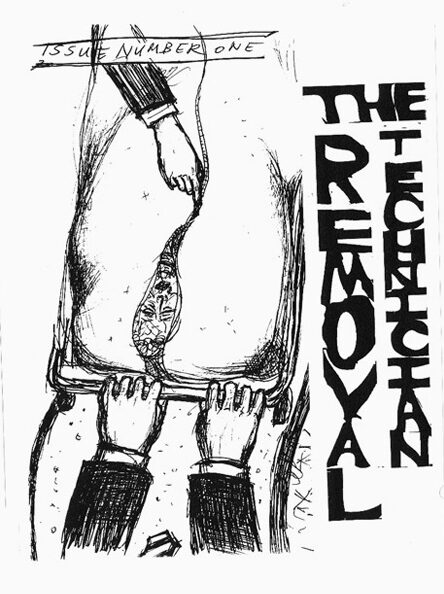
MARK: OK, let’s start at the beginning… Do you remember the circumstances of how you first met one another?
ALEX: I think Dan confused me for this other guy, Kevin, who was his close friend.
DAN: I don’t recall ever being friends with anyone named Kevin… Alex and I met during our first year of college, probably in the spring of 1994. We met through mutual friends, although certainly not Kevin. Alex had huge old car, a 1963 Ford Galaxy, I think. We could easily fit six or seven people in there, and we would spend a lot of time driving around Portland on the weekends. Alex dropped out of school after our second year, but we stayed in touch.
MARK: When you say that you could “easily fit six or seven people” in his car, you’re talking about living people, right? I mean, I assume you didn’t have to use your own car when transporting bodies…
DAN: Yeah. The standard vehicle for removing bodies is a minivan. Our van was a pleasant teal color. With the back seats removed, a minivan can comfortably fit two of the rolling cots that are used for removals. This makes it possible to go directly from one removal to another without returning to the funeral home to drop off a body. I’ve never driven a hearse, but my sense is that a minivan is far superior for removals.
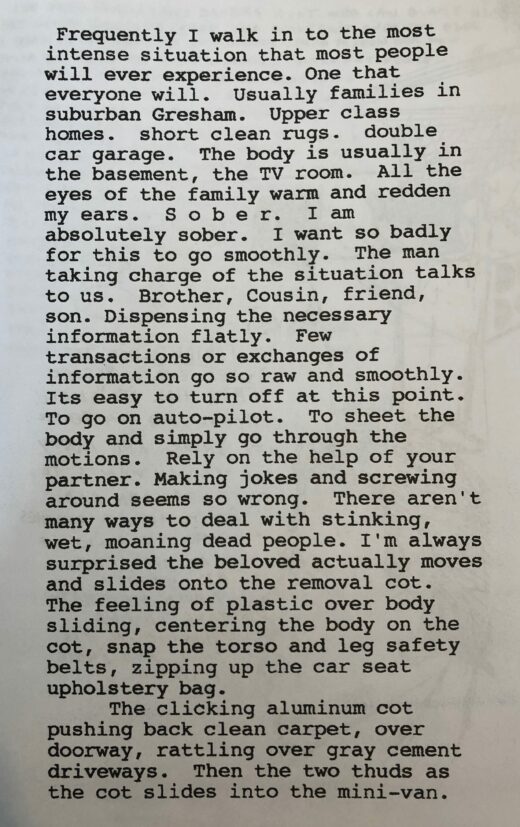
[above: Issue 1, Page 8, The Removal Technician.]
MARK: Speaking of your ability to move two bodies at a single time, did you ever have to deal with a murder suicide? I suspect it’s bullshit, but someone just last night told me a story that she’d heard about a dying man handcuffing himself to his wife, who — I guess being unable to call for help, or chew through his arm — died by his side a few days later. I don’t suppose you ever encountered two bodies handcuffed to one another, did you? Would I be right to assume that you never had to deal with any potential criminal cases, as the authorities would take those bodies?
DAN: In a case like that, I think the bodies would be removed by a coroner, or something like that. That handcuffing story sounds interesting, perhaps unlikely, but who knows. In criminal cases there are specific guidelines for handling bodies, I assume. We did once do a removal after an autopsy. If I remember correctly it was a homeless guy who died on the street. His stomach and chest had been flayed open and then stitched back up.
ALEX: His name was Danny K, and he had hung himself in a desolate part of a park with his shoelaces. I remember being shocked that his laces had help up… He was a massive person… When Dan and I started at Loewen, they didn’t have the license or permits to go to crime scenes yet. Later, when I worked for Lowen without Dan, they were adding this service. Luckily, I didn’t get that type of call, though.
MARK: Will all the “Kevin” references make sense to me once I read the back issues of Removal Technician? I’ve ordered them from Primary Information, but they’ve yet to arrive… Back to the removal van, did you have a nickname for it? And, was it somehow refrigerated? And, if not, was odor an issue, seeing as how you were transporting decomposing bodies?
DAN: No nicknames, and no refrigeration. We would get to the bodies within a few hours of death, well before they began to decompose. The key scent I associate with the van is hand sanitizer and a slight scent of poo from released bowels.
MARK: Alex, how about you? Do you have fond memories of the van?
ALEX: The great thing about the removal van was that it allowed Dan and I to go to thrift stores and Chinese restaurants in East Portland between calls. We never did errands or shopping with a body in the back, though. Dan and I were always very respectful of the bodies. I remember the blue corduroy fabric that covered the bodies very clearly, the removal cots had these heavy built in body covers that you would zip up when the deceased was loaded on. I think I made a drawing of that man being moved with his Dirt Bike Magazine.
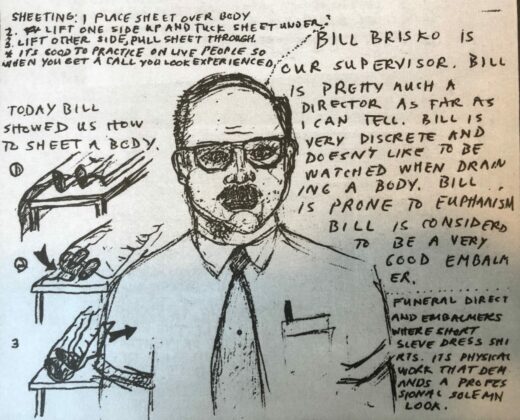
[above: Issue 1, Page 18, The Removal Technician. Zoom in.]
MARK: So, where was it that you were going to school? And why did you decide to drop out, Alex?
DAN: We went to Lewis & Clark College in Portland.
ALEX: I’d been at Lewis & Clark for two years. I was having family issues, and followed my girlfriend at the time to California. I was there for two years before moving back to Portland and starting art school. The first issue of Removal Technician was made during a Summer vacation, when I was attending community college in California.
MARK: OK, so you two had met at Lewis & Clark, but you weren’t both students there while you were making The Removal Technician? Alex, you were back in Portland for the summer, on a break between semesters at art school… And what were you doing at the time, Dan? Had you graduated from Lewis & Clark by then?
DAN: I graduated from college in 1997 with a degree in philosophy, and no clear idea of what I wanted to do.
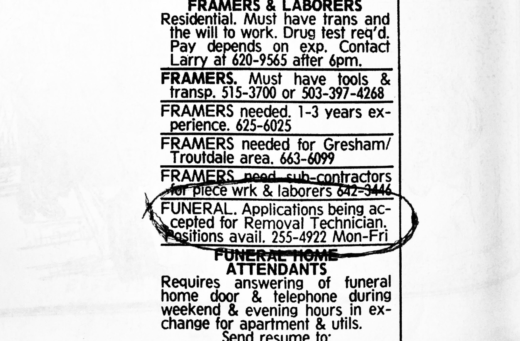
MARK: So that’s how you came to be working in the death industry?
DAN: Yeah, I saw a help wanted ad for a removal technician and applied. In the interview, I explained that my background in philosophy would help me deal with the bereaved. I don’t know why I applied for the job. I guess it seemed interesting, different than my previous jobs – working in an office, washing dishes, and doing the late shift at a Plaid Pantry. I was hired, and ended up training with a group of aspiring death industry workers. I was the youngest one of the bunch. Removal technicians always work in pairs, so I worked for a few weeks with a guy named Jason, who is described in the zine. He wasn’t much of a talker, and it was really awkward not being able to discuss the stress of handling the dead. After a few weeks, I got Alex to apply, and somehow we convinced our manager to let us work together. Alex was living out in Newport with his mom at the time, and would drive in on the weekends. We worked two twelve-hour shifts every weekend. It was nice to have five days off, kind of an ideal schedule at the time.
MARK: Did it take much persuading to get you to sign up, Alex?
ALEX: No, I remember Dan telling me about a mutual friend applying for the job and being jealous.
MARK: You mention that part of the job involved having to deal with the bereaved. Can you talk a bit about that?
DAN: There was some basic information we needed to collect: phone numbers, addresses, this sort of thing. Occasionally it was necessary to pull a wallet out of the deceased’s pocket to get some of this info. I did most of the talking, perhaps because I had been on the job longer than Alex. I found it effective to speak in a quiet, barely audible voice. Aside from collecting information I avoided engaging with the bereaved or doing anything that would resemble consoling. In practice, my background in philosophy was underutilized.
ALEX: I don’t think I had a very good presence on the removals. I would generally stay quiet. I remember a husband, newly widowed, on our first call. I remember he was worried about me looking so sad or shocked. He was so nice despite the fact that he had just lost his wife, joking with Dan about needing to take care of me.
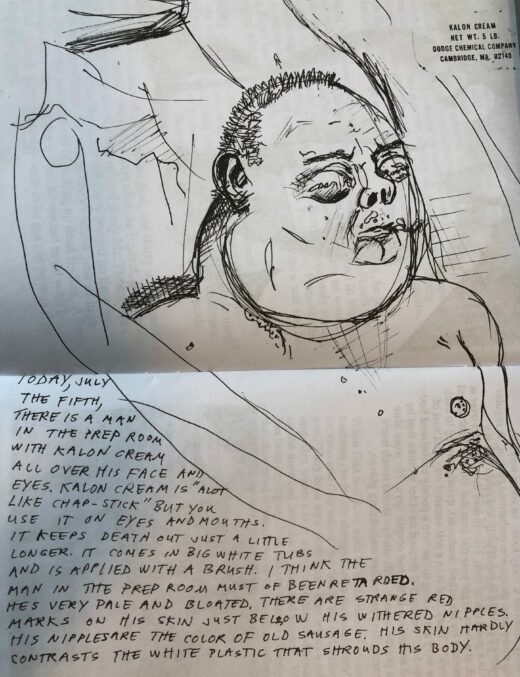
[above: Issue 1, Pages 15-16, The Removal Technician. Zoom in.]
MARK: I’m trying to think of other professions that demand people to have such a wide range of skills. I mean, it seems like two completely different things – lugging dead bodies, and dealing with the bereaved. I can think of people in my own life who might be well suited for either task, but not both. And I’m wondering how difficult it is to find people in that sliver of the Venn diagram where those two competencies overlap. Or is that maybe why it’s a two-person job…
DAN: The level of engagement with the bereaved was actually pretty minimal. The lifting/maneuvering skills were more important. That’s really why two people are essential for a removal. You don’t want to be struggling with a body in front of the deceased’s family and two people can make the job go far smoother. For those who go on to run a funeral home interpersonal skills are far more important. Most of the other removal technicians aspired to run a funeral home, but I would say that only a couple of them really had the personality for that side of the work.
MARK: How did the two of you divide up tasks?
ALEX: Dan did all the talking and the physical tasks were evenly divided. We got quite good at the whole process; sheeting, getting the gurney back up off the floor and getting out of the house. It also takes practice getting a loaded gurney smoothly back into the Removal Van. My worst struggle was almost letting go of a loaded gurney – going down steep carpeted stairs of a McMansion in East Vancouver. This was after Dan had quit removals and I was at art school, Dan had moved on to the Green House which was a place in portland that had services for homeless youth.
MARK: I’ve only handled one dead body. I was a bellboy at a hotel in ‘93, and a guest had died during a reunion of his WWII platoon. He was probably in his 80s, and he died on the toilet. When hotel management got the word from the man’s wife, I was sent up to the room along with a hotel lifeguard to see if we might be able to resuscitate him. He was cold to the touch, and his blood had already pooled in his legs. We knew there was no point, and his wife, who was a nurse, knew it too. As the paramedics hadn’t shown up yet, though, we tried… So I have some experience when I say that moving a dead body isn’t nearly as easy as they make it look in the movies…
DAN: We had to remove at least one person who died on the toilet. Bathroom removals are some of the most difficult, particularly if rigor mortis has set in. The small space of the bathroom makes it necessary to stand the body partially upright in order to maneuver. We describe our struggles with a bathroom removal in The Removal Technician. Removing a body from a bathroom seems like a lot to ask from a hotel bellboy.
MARK: Looking back on it, I’m glad that I had the experience. Prior to that, I don’t think I really appreciated just how different living people were from dead ones. I mean, I’d been to funerals, and I’d seen bodies, but, when you’re really close to a body, it becomes really clear that, without the spark of life, these bodies of ours are pretty much just giant, ugly pieces of luggage. It makes you understand how people came up with the concept of the soul.
ALEX: Yes I remember my first day after work, just the idea of human animation seemed really important to me. I remember thinking it’s essentially corpses moving around a grocery store. It was time to dance.
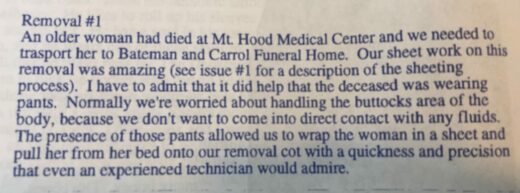
MARK: Was The Removal Technician the first zine for both of you, or had you published anything prior to that first issue, which came out in ‘97?
DAN: I don’t think either of us had done anything zine-like before that, but there were always a lot of zines floating around the houses where I lived in the ‘90s. In 1995, I was living in Southeast Portland, just a few blocks from the first Reading Frenzy site. My housemates and I would often walk down there and buy a few zines. I think the zine Dishwasher, with its focus on work, might have been an inspiration. There was also a zine about pills, Pills-a-go-go, that I liked, and one called Hessian Obsession that was written by Quitty from the Mukilteo Fairies that I was fond of… After The Removal Technician, I was a regular contributor to a zine some friends I grew up with started in 1998 – The Alvadore Journal – named after the small town outside of Eugene where we grew up. That zine ran for more than ten years, and had close to twenty issues.
MARK: As you mention Dishwasher, I’m curious to know if you — even for a moment — considered employing the same conceit… instead of attempting to wash dishes in all 50 states, attempting to handle dead bodies in all 50 states.
DAN: There was a time when I would see funeral homes while traveling and imagine myself working there. It’s perhaps not as portable of a skill as dishwashing, but a person could probably travel from town to town removing bodies.
MARK: Whose idea was it to take these experiences that you were having, and use them as fodder for a zine?
ALEX: I think I was making mean doodles of our co-workers, and Dan saw the potential for a larger project. We would spend so much time after work telling the same stories to people about what pickups we’d done that day. It made perfect sense to write it all down and photocopy it. Once we’d committed to making our own zine there was so much material to use; funeral industry trade magazines, labels from mortuary supplies, bodies, removal techniques to explain, pamphlets for those experiencing loss, internal gossip… There was a small library at the funeral home that had some historical embalming books… also “love letters” that one coworker was writing.
DAN: Yes, we had a lot of downtime between pickups. The office in the funeral home had lots of scrap paper for writing down information about removals. There was an old typewriter in the office too, and I would use that, or write by hand, while Alex drew. All of the writing and drawing was initially a way to deal with the stress of the work, but soon we started accumulating enough good stories and images that it made sense to put together a zine.
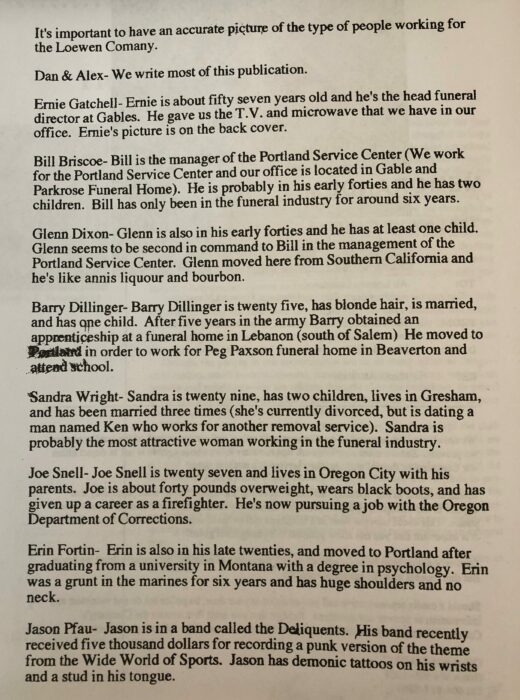
[above: Issue 1, Pages 3, The Removal Technician. Zoom in.]
MARK: Did you have other friends at the time who had zines?
DAN: Not really. Like I said, my friends from Alvadore started a zine later, and we kept that going for many years, but that was later.
MARK: So, aside from spending time at Reading Frenzy, and being inspired by zines like Dishwasher, did you have any interaction at all with other zine folks in Portland as you were working on The Removal Technician?
DAN: Sean from Crap Hound gave me a call after seeing the first issue at Reading Frenzy. He was super helpful with improving the quality of production. I was sort of into the low quality aesthetic, but Sean quickly convinced me that there was no reason that zines had to look like shit. He had some nice equipment that was good for scanning photos and this sort of thing. He also passed on some tricks for dealing with Kinko’s. We tried to reciprocate with some death related images for Crap Hound.
MARK: By “tricks for dealing with Kinko’s,” do you mean that he hooked you up with someone working on the late shift who wouldn’t charge you? It’s OK, I doubt they’ll come after you at this point.
DAN: Sean lent me an extremely powerful magnet. Back in 1997, Kinko’s had counters that you inserted into the copy machine while making copies. When you were done you took the counter to a clerk, who then charged you, and used a magnet to reset the counter. With Sean’s magnet I would make my copies, reset the counter myself, and then make and pay for a few copies, so it wasn’t completely obvious that I was ripping them off. It was pretty great, except for the fact that, on at least one occasion, the magnet erased a cassette tape that I had in my backpack.
MARK: You mention that Sean had scanner and other equipment… Were you actually doing production work for the second issue in his apartment?
DAN: Yes, I specifically remember scanning, and then printing photographs. Our previous method had involved photocopying the photos, which looked like crap.
MARK: So, do we have the both of you to thank for the fact that issue #6 of Crap Hound is Death, Phones and Scissors, and not something like Wigs, Phones and Scissors, or Hatchets, Phones and Scissors?
DAN: I think it was Sean’s interest in death that led him to reach out to us. He was already working on Death, Phones, and Scissors at the time, and I believe a couple of the images in that issue came from old funeral industry literature that we’d borrowed from the funeral home.
MARK: Did management at the funeral home ever become aware of what you were doing? If so, how did they react?
ALEX: Not that I am aware of… I think we would have been quickly fired.
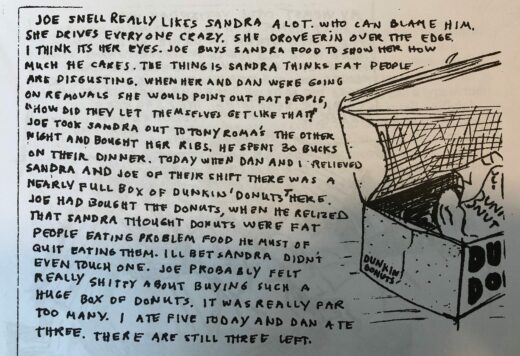
[above: Issue 1, Pages 10, The Removal Technician. Zoom in.]
MARK: OK, I just received and read both issues of The Removal Technician, and I’m struck by just how much you share about your coworkers, like Sandra (“probably the most attractive woman working in the funeral industry”), Glenn (who seems like he’d probably be enjoying his job a little more “if he was fucking dead people”), Bill (who “doesn’t like to be watched when draining a body”), and Barry (who likes to handle the dead bodies with bare hands, thinking that it adds a “personal touch”). While I like the behind-the-scenes look at the funeral industry, it’s the little things — like the mention of Joe’s ill-fated attempt to seduce Sandra with a huge box of donuts — that I most enjoyed… But, yeah, I’m struck by just how specific you got. I mean, you name the funeral home. And you name your co-workers, giving both their first and last names. Am I right to assume that you weren’t using aliases? I’m really surprised that no one ever called up the funeral home, after having read about these people. Had I read it back in ‘97, I think I would have called to see which of your coworkers might answer.
DAN: I’m not sure exactly why I thought it was so important to use people’s names in The Removal Technician, but I think it had something to do with an obsession with the real. The names somehow seemed like an essential part of who these people were. There’s a page in Issue 1 where I describe our office in great detail — the desk, the chairs, the lamp. Reading it now, I wonder why this was included along with the more sensational stuff about picking up bodies, but, at the time, all of these details felt important. It was something of a surreal experience to be picking up bodies, especially initially. I sometimes felt like I was watching myself, not sure how I had got myself into this situation where I was removing a body from a bathroom and then collecting information from family members. People’s names, their stories, the office furniture, every mundane detail seemed essential to that experience, like it would be a fabrication if we didn’t include the names.
As for people calling the funeral home or trying to track down our co-workers that was unlikely. First, that was less of a thing that people did back then when fewer people were using the Internet. The sort of random person who becomes a celebrity for a couple days wasn’t common then. Hard to imagine any of our readers having a strong urge to hear Barry’s voice or chat with Bill about embalming. Second, the distribution of The Removal Technician was extremely small. We gave a few copies to our friends and sold it at Reading Frenzy. We maybe sold twenty copies of Issue 1 and ten copies of Issue 2. The only person who ever contacted us was Sean and he got our number from Chloe.
ALEX: I remember being shocked that we had sold the first few copies, like 6 copies sold and we were able to buy personal pitchers of beer and gyros at the Marathon Tavern with the money. That success was far greater than we had imagined. The idea of an audience was so beyond my thinking when we made these.
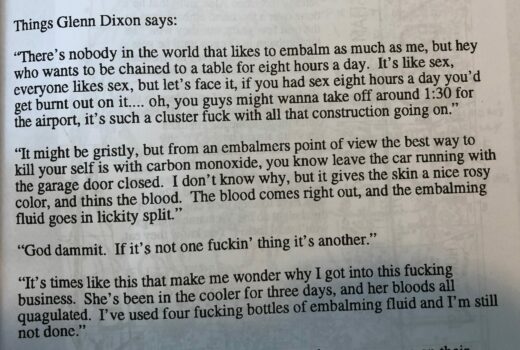
[above: Issue 2, Pages 10, The Removal Technician. Zoom in.]
MARK: This obsession with documenting the lives of people seems to have stuck with you, Dan, as you’re now an anthropologist, right?
DAN: Yeah, I continue to write about people. Now, though, I don’t use their names, and I change personal details to obscure their identities. I didn’t study anthropology as an undergraduate, and I really had never thought seriously about issues of representation when writing The Removal Technician. If I were to do it again, I would not include names, at least for the other technicians. Even in my current writing, I think I have a tendency to err on the side of providing more factual information about people than necessary. If you really wanted to, you could probably go to the cities in Ethiopia, where I do research, and track down the people I write about, just using the life histories that I describe. I still have a hunch that the details of life are important, although I can’t articulate exactly why they’re important. Anthropologists often create characters that are composites of different people, but I do this less than others. In order to hide people’s identities anthropologists make up fictional towns, or companies, or organizations. I don’t do this at all. I think the cities I write about are important, and I don’t attempt to hide the identities of public figures. I think these are histories that need to be documented. In terms of The Removal Technician, if I had to do it again I wouldn’t include names, but I would still note that we worked in Portland, for the Loewen Company. Places like Portland and Gresham are part of a broader story about economic change and I think that specific history is valuable.
MARK: Some of the stuff in The Removal Technician, as we’re discussing, gets pretty specific. For instance, you reprinted something from the personnel file of a coworker — a letter he’d written to someone about how he thought “Barry (was) a pud-fucker”, and how he masturbated to thoughts of Sandra. Was there anything you censored? Short of not photographing the faces of the dead, did you ever draw a line?
DAN: Yes, there were some things we chose to censure. Alex and I both have a dark sense of humor, and we certainly wrote up panels that were not included in The Removal Technician… And things also change over time. When Primary Information expressed interest in reissuing The Removal Technician, we had the opportunity to change things. I actually requested that the panel where Alex fantasizes about a co-worker masturbating be removed, as it seemed insulting to the co-worker. Although we completely destroyed our co-workers’ privacy, with the exception of that panel, we were generally respectful. The panel wasn’t removed, by the way. I’m not sure why.
ALEX: I want to be clear Dan is using the term fantasizing in the “imagining” way not in the wishing or hoping to experience form. Most of my contributions were drawn to make Dan laugh while we killed time at the desks we sat at waiting for calls.
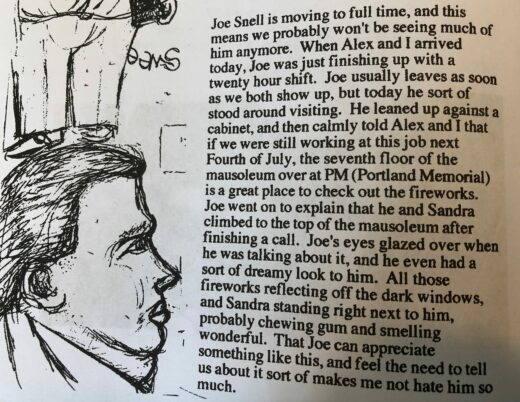
[above: Issue 2, Pages 9, The Removal Technician. Zoom in.]
MARK: There are so many great quotes, but I want to share one that I think gets to the heart of this world you invited people into. It’s a quote from your coworker, Glenn Dixon. “It might be gristley, but, from an embalmer’s point of view, the best way to kill yourself is with carbon monoxide,” he told you. “You know… leave the car running with the garage door closed. I don’t know why, but it gives the skin a nice rosey color, and thins the blood. The blood comes right out, and the embalming fluid goes in lickety-split.”
DAN: The “Stuff that Glenn Dixon says” page still makes me laugh. Glenn was generally a quiet guy but occasionally he would sit us down and share some serious knowledge.
MARK: The first issue includes a drawing of a corpse’s feet, which is attributed to Alex’s mother. I’m curious as to how that came about.
ALEX: I don’t remember specifically but I do remember a few road trips to my moms in Newport at the time. I feel like it involved a lot of Carlo Rossi wine and spaghetti. There was a video game at my moms house and that was the cover image, two feet with a body tag.
MARK: You mentioned that, prior to the zine, you’d stop by Reading Frenzy. Did you spend more time there after the release of the first issue?
ALEX: I was too shy to talk to Chloe, but Reading Frenzy was definitely a stop when wandering downtown. That quadrant of Portland was very active; Powell’s was across the street, the cafe that may have spawned the Portland Bird Art phenomena was next down the hill, and Rocco’s Pizza was next door. Reading Frenzy was a hub when wandering around.
DAN: We also took great pleasure in collecting money (two or three dollars) from the zines we sold on consignment at Reading Frenzy. We had a sort of unspoken agreement that the money had to be spent on beer.
MARK: Was there ever drinking on the job?
DAN: Maybe a beer near the end of our shift, if we were confident that no more removals were coming, but we saved the drinking for after work.
MARK: Did you ever mix zine business and funeral home business? I just had this vision of you double-parking a van with a body in it so that you could drop copies of the zine off at Reading Frenzy… Did anything like that ever happen?
ALEX: I’m not sure we ever actually visited Reading Frenzy in the removals van, but we definitely used the copier in the funeral home office a few times. The office for the removal technicians was in a separate part of the funeral home from the actual offices for the funeral directors – past the coffin display and around from the chapel. It’s all hazy in my mind, I really only remember that office / church feeling and muted colors and light. Most of our down time in the van was spent eating chinese food and looking for records. It was a real luxury at the time to have a van and work issued cell phones.
DAN: Yes, The Removal Technician office was out near 82nd street, and we’d drive around there all the time. We had a favorite Chinese restaurant, one of those giant empty places with the big red booths, a taqueria we liked, and a few thrift stores where we’d dig through the record bins. Driving downtown to the Reading Frenzy in the van would have been a hassle. I don’t remember ever doing removals downtown. I was again living close to Reading Frenzy’s new location in 1997, so it was a nice destination for a walk or bike ride.
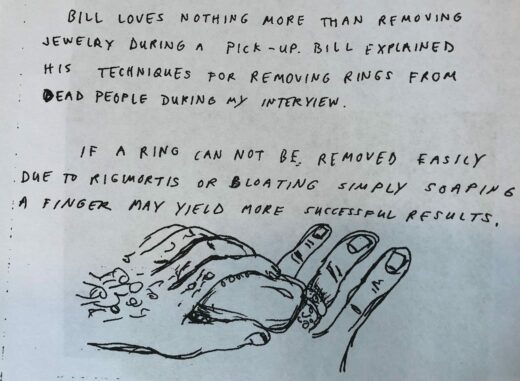
[above: Issue 2, Pages 15, The Removal Technician. Zoom in.]
MARK: Alex, as Dan noted above how the experience of putting out The Removal Technician kind of still ripples his work today, I thought that I’d ask you the same thing. Do you see any connection at all between the zine and your artwork today in terms of content, theme or approach?
ALEX: Not directly, but I do remember a moment when first attempting to layout the pages and finding such pleasure in making connections visually between text and image. I think there was an ad from the turn of last century featuring embalming needles on one page and a drawing of spindly legs on the facing page.
MARK: What kind of mail did you get? Did people ever share their death stories? Did any other death industry workers ever write in?
DAN: There was never any mail. Most of our readers were our friends. The handful of zines that were sold at Reading Frenzy had the potential to circulate in unexpected directions, but, for the most part, The Removal Technician was something we did for ourselves and our friends.
MARK: Did your views on life and death change at all over the period of time that you worked as removal technicians?
DAN: We used to talk about how dead people don’t always look so different than living people. Nothing too deep here, just a vague sense that the barrier between life and death could be crossed at any moment… Spending time in nursing homes was one of the difficult aspects of the job, and perhaps made us think about aging. The removals were easy — a simple slide out of the bed into a cot, and no need to talk with family members or anything like that. But the nursing homes were a reminder of what happens to old folks in the US. There was always an old man crying, “Nurse!”, the smell of urine, and terrible lighting.
MARK: Why did you stop publishing Removal Technician? And, had you kept at it, what would issue #3 have been like? I’m curious as to what happened to these people.
DAN: We only worked at the job for that summer of 1997, so The Removal Technician had to come to an end. Perhaps two issues were all that was necessary. The shock of dealing with dead bodies decreased with time, and we were writing more about our co-workers. Their stories are interesting, but once I started working with Alex I didn’t see them as often.
MARK: Did you both leave the funeral home at the same time? Or did one of you say on after the other left?
DAN: Alex did an occasional shift while going to art school in Portland. I have a memory of accompanying him on a removal. I think that happened, but it might have just been something we talked about doing.
MARK: In 2001, HBO started airing the series Six Feet Under, a drama about a family-run funeral home. Assuming you watched it, I’m curious what you thought… Did they ever show removals? And, if so, were they realistic?
DAN: I never watched it. When we were doing removals we sometimes would pass the time spinning out shows about removal technicians – turning the zine into hollywood script, removals + comedy + romance. When Six Feet Under became popular I felt like we’d missed our boat.
[If you should find yourself still wanting more, you can find scans of The Removal Technician on-line, or purchase copies for yourself through Primary Information… Oh, and if you haven’t already, check out the other interviews in the Untold History of Zines series.]




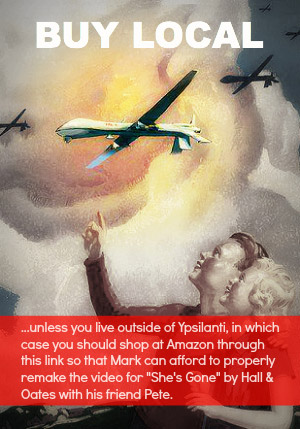

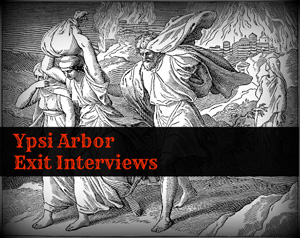
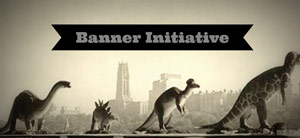
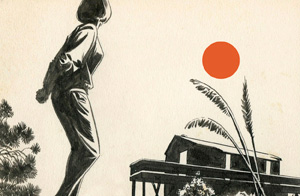



7 Comments
“Bill loves nothing more than removing jewelry (from the recently deceased).”
It makes me wonder if I’d love that too. What if that would have been my true passion in life, but I never knew it, as I’d never had a chance? What a sad thought this cold winter’s night.
Everyone should have had a zine as a young adult. The world would be a better place.
I would like to know if they have read Faulkner’s ‘As I Lay Dying.’
I re-read it recently after learning my great great grandfather’s dead body was moved by horse and wagon from San Francisco across the Central Valley and up to the Sierras in the Summer.
It’s a truly great book.
Also recommended: The Undertaking by Thomas Lynch, who is an undertaker and poet from Milford. It’s a boon of essays about his craft and community. Undertaking has been his family’s business in Milford for generations. For those who imagine life outside the A2-Ypsi-Detroit corridor to be mundane, it’s well worth a read. Judging small town rural life as boring is a bit like being a kid imaging that adulthood is boring.
For those who need their reading to be credentialed. Lynch’s book won the American Book Award and was short listed for the National Book award. It would be really cool if MM interviewed him.
Loved the interview, we would have carried it at Atomic Books had we know about it. And kudos to them for putting the issues online!
That would have been one of my top 10 zines! You asked the questions I wanted answered! I was just talking about how I think I could work with corpses.